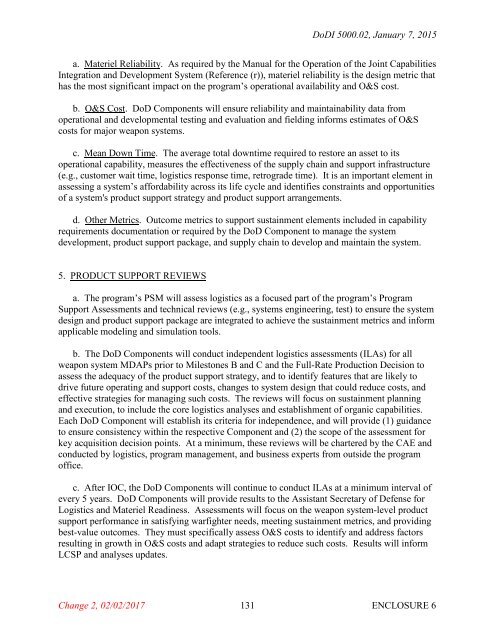Department of Defense INSTRUCTION
x9tnk
x9tnk
You also want an ePaper? Increase the reach of your titles
YUMPU automatically turns print PDFs into web optimized ePapers that Google loves.
DoDI 5000.02, January 7, 2015<br />
a. Materiel Reliability. As required by the Manual for the Operation <strong>of</strong> the Joint Capabilities<br />
Integration and Development System (Reference (r)), materiel reliability is the design metric that<br />
has the most significant impact on the program’s operational availability and O&S cost.<br />
b. O&S Cost. DoD Components will ensure reliability and maintainability data from<br />
operational and developmental testing and evaluation and fielding informs estimates <strong>of</strong> O&S<br />
costs for major weapon systems.<br />
c. Mean Down Time. The average total downtime required to restore an asset to its<br />
operational capability, measures the effectiveness <strong>of</strong> the supply chain and support infrastructure<br />
(e.g., customer wait time, logistics response time, retrograde time). It is an important element in<br />
assessing a system’s affordability across its life cycle and identifies constraints and opportunities<br />
<strong>of</strong> a system's product support strategy and product support arrangements.<br />
d. Other Metrics. Outcome metrics to support sustainment elements included in capability<br />
requirements documentation or required by the DoD Component to manage the system<br />
development, product support package, and supply chain to develop and maintain the system.<br />
5. PRODUCT SUPPORT REVIEWS<br />
a. The program’s PSM will assess logistics as a focused part <strong>of</strong> the program’s Program<br />
Support Assessments and technical reviews (e.g., systems engineering, test) to ensure the system<br />
design and product support package are integrated to achieve the sustainment metrics and inform<br />
applicable modeling and simulation tools.<br />
b. The DoD Components will conduct independent logistics assessments (ILAs) for all<br />
weapon system MDAPs prior to Milestones B and C and the Full-Rate Production Decision to<br />
assess the adequacy <strong>of</strong> the product support strategy, and to identify features that are likely to<br />
drive future operating and support costs, changes to system design that could reduce costs, and<br />
effective strategies for managing such costs. The reviews will focus on sustainment planning<br />
and execution, to include the core logistics analyses and establishment <strong>of</strong> organic capabilities.<br />
Each DoD Component will establish its criteria for independence, and will provide (1) guidance<br />
to ensure consistency within the respective Component and (2) the scope <strong>of</strong> the assessment for<br />
key acquisition decision points. At a minimum, these reviews will be chartered by the CAE and<br />
conducted by logistics, program management, and business experts from outside the program<br />
<strong>of</strong>fice.<br />
c. After IOC, the DoD Components will continue to conduct ILAs at a minimum interval <strong>of</strong><br />
every 5 years. DoD Components will provide results to the Assistant Secretary <strong>of</strong> <strong>Defense</strong> for<br />
Logistics and Materiel Readiness. Assessments will focus on the weapon system-level product<br />
support performance in satisfying warfighter needs, meeting sustainment metrics, and providing<br />
best-value outcomes. They must specifically assess O&S costs to identify and address factors<br />
resulting in growth in O&S costs and adapt strategies to reduce such costs. Results will inform<br />
LCSP and analyses updates.<br />
Change 2, 02/02/2017 131<br />
ENCLOSURE 6


